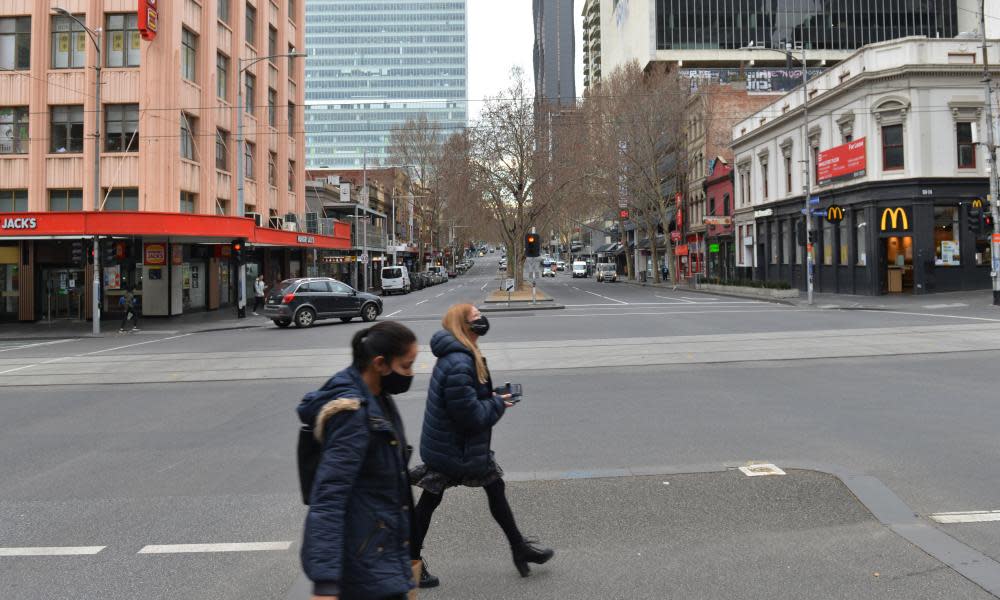Call to vaccinate younger Australians as data reveals they’re hardest hit by Covid

Younger Australians have borne the brunt of the Covid pandemic with people aged in their 20s hit by more cases than any other age group, according to a Guardian Australia analysis of department of health data.
But, while the number of coronavirus cases was highest among those in their 20s, followed by those in their 30s and 40s, the severity of the illness was far worse among older Australians.
Australians aged over 80 had a disproportionately high number of cases and deaths, with most of these occurring during Victoria’s extended outbreak last year.
Related: ‘Health systems should be prepared’: doctors brace for tsunami of long Covid
Professor Marylouise McLaws, an epidemiologist at the University of NSW, says 20-39-year-olds have been at severe risk of infection throughout the pandemic.
“We have seen young people having 40% of the burden even before Delta. They are lower socioeconomic [status]. They often work in multiple jobs or live in crowded households because they either like it or they need to do that. So it’s not a surprise that 20-39 year olds are at an enormous risk,” McLaws said.
“And yet they have been neglected because [they] can’t get in for love or money to get a vaccine”
Those aged in their 20s and 30s have had a significantly higher percentage of Covid cases than would be expected given their share of the population.
On a per capita basis, Australians aged over 90 have had significantly more cases than any other age group.
Despite the case load skewing overwhelmingly younger, older Australians have borne the brunt of deaths. Those aged over 80 are a relatively small proportion of the Australian population, but more than 40% of deaths in the pandemic have been in the 80-89 age group.
To date only one person in their 20s has died. Five people in their 30s or 40s have died. These three age groups account for about 40% of the population.
Adjusting the number of cases and deaths to a rate per 100k population shows that those over 90 have been hit much harder than any other age group.
There have been more than 400 cases and 150 deaths per 100k people over the age of 90. For people in their 80s, the figures drop to almost 50 deaths and more thn 150 cases per 100k people.
Data published by the health department at the beginning of March last year shows cases skewing slightly to older demographics. 50-59 year olds made up 20% of new cases at that time, with those in their 40s and 30 year olds accounting for 15% each. But this was likely biased by early infections in overseas travellers.
Related: Sydney Covid crisis could take months to recede if other outbreaks are anything to go by
Most of the infections in Australians aged over 70 occurred during Victoria’s extended second wave last year. The number of Covid cases per 100k people aged over 80 jumped from 64 at the beginning of August 2020 to over 140 by month’s end.
McLaws says many of the infections in older Australians were in aged care facilities, where residents were a “captive audience”.
“When you are looking at the older group it’s really confounded by the fact they were a captive audience, with hospital in the home. So they didn’t have a chance of escaping someone who was positive in the household. And that’s what we are seeing with Delta now.
“The biggest two categories of risk are not socialising anymore, they are workplace and households. And residential aged care facilities are households. They are just shared households.”
By the beginning of November 2020, more than 390 people per 100k aged 90 or over had contracted Covid. But since then the proportions of infections in these age groups has largely remained stable – whether there is an outbreak or not.
Those over 60 were also prioritised early in the vaccine rollout.
Australians aged 40 and under have consistently made up around 60% of new infections every fortnight, according to the fortnightly epidemiology reports released by the department of health. But relatively few of these are aged under 10 – around 5% of all cases. This is less than half their proportion of the population.
The federal epidemiology reports do not include current data on the latest outbreak in Sydney. Data scraped from the department of health website by Ken Tsang shows those under 40 have continued to make up the majority of new cases over the past two months.
Most younger Australians have been ineligible for vaccines, unless they fall into a small number of jobs or have pre-existing medical conditions. New South Wales and Victoria have recently relaxed vaccine eligibility slightly, but many are still having trouble booking shots.
McLaws says the vaccine priority needs to change, given what we’ve seen in the community as well as overseas.
“The epidemiology is screaming to me that we have been neglecting our young. Apart from the fact that they are our next generation … they are also at the greatest risk of transmitting. Just like carers in residential aged care facilities are the greatest risk of transmitting to our elderly,” McLaws says.
“They have to open up right now the vaccine to anybody that turns up. But give priority, have a special queue, for the 20 to 39 year olds.”

 Yahoo Movies
Yahoo Movies 
